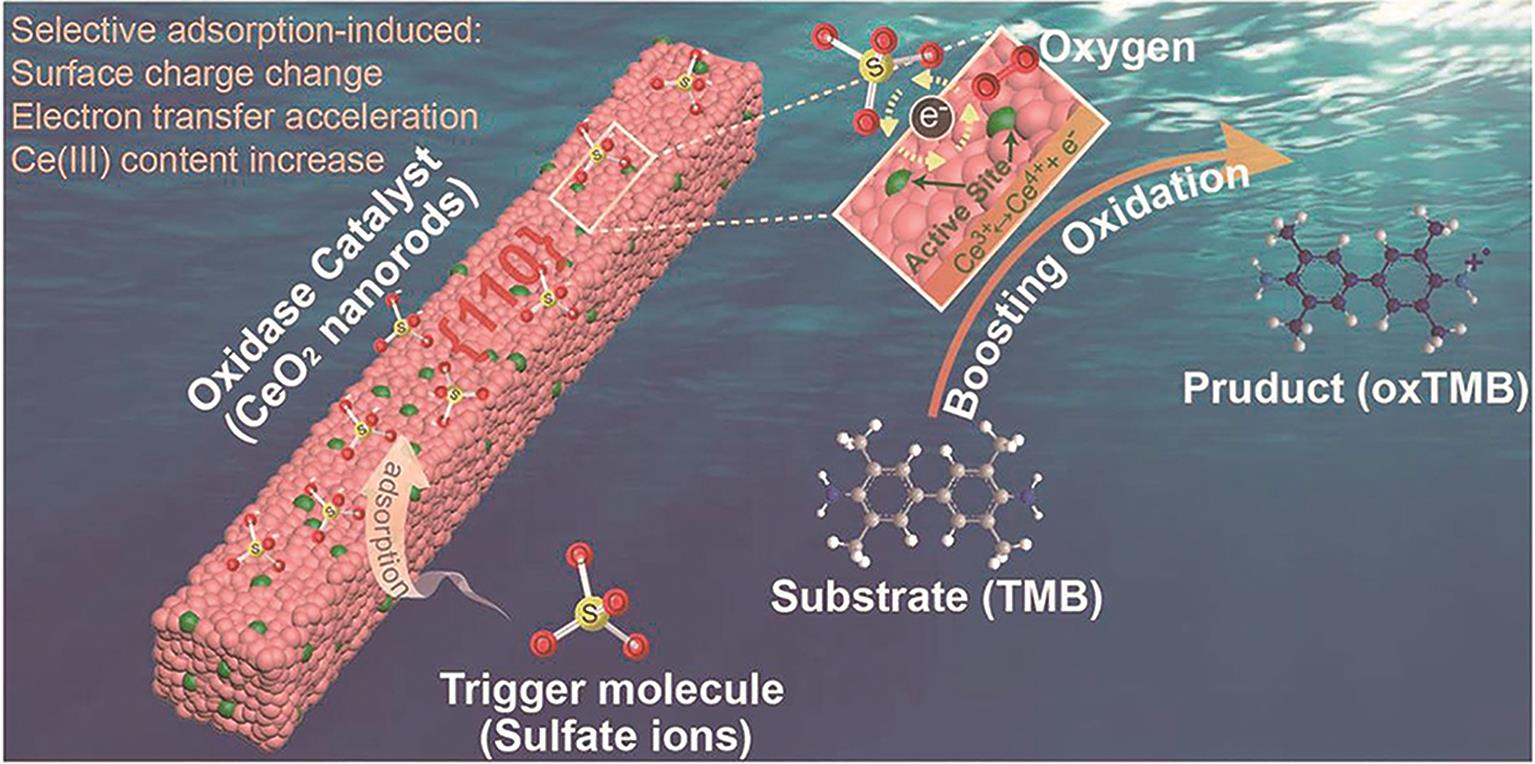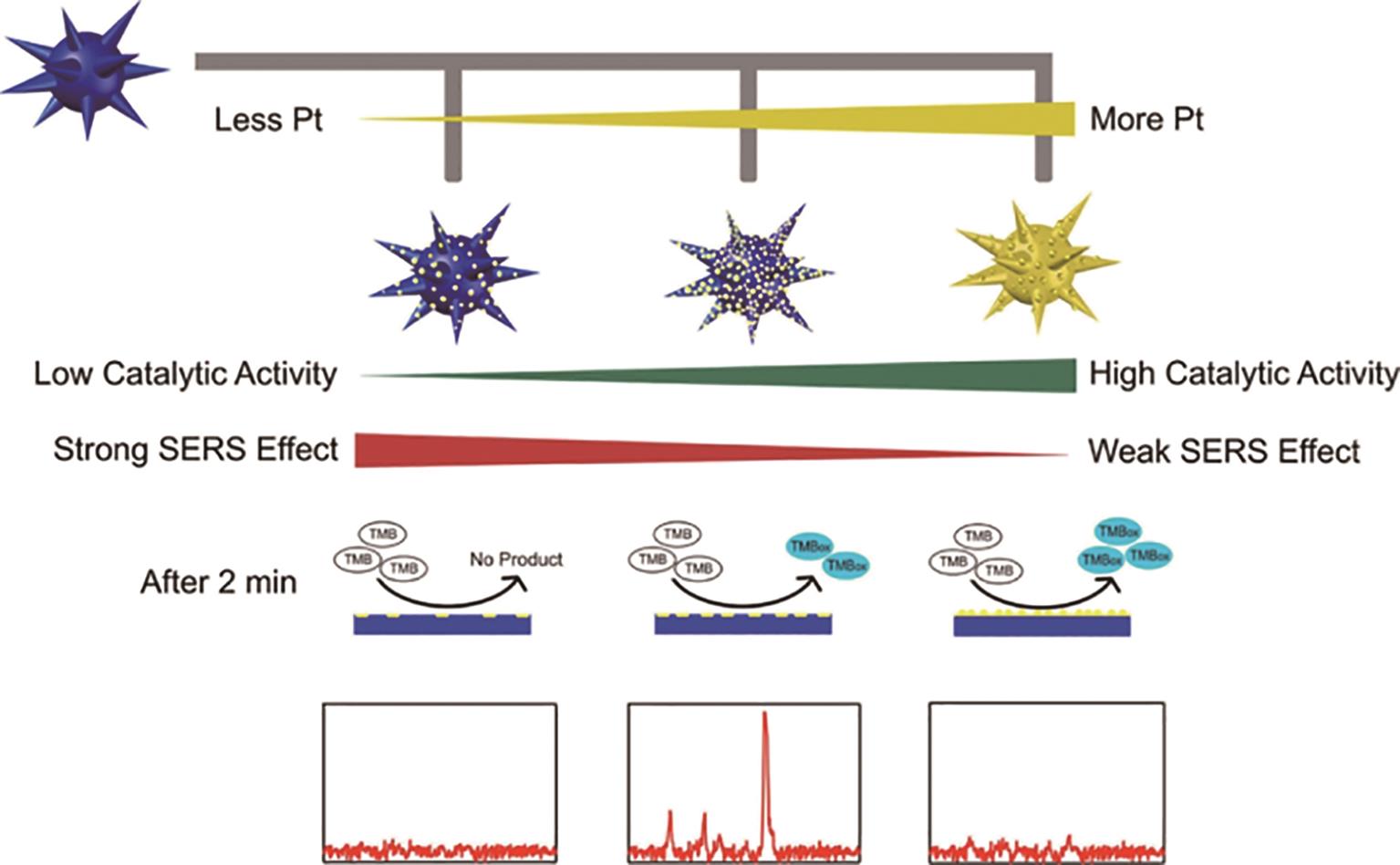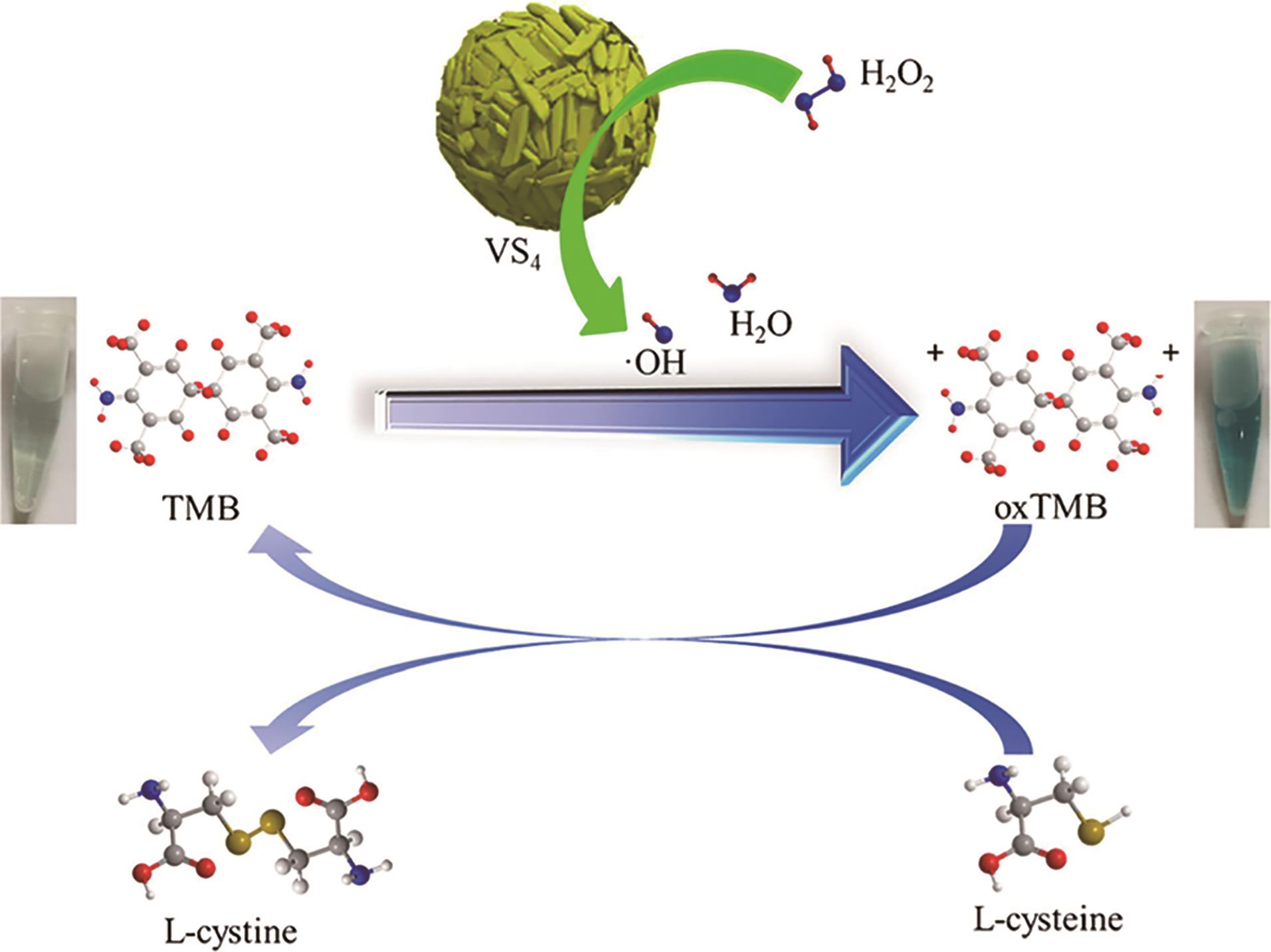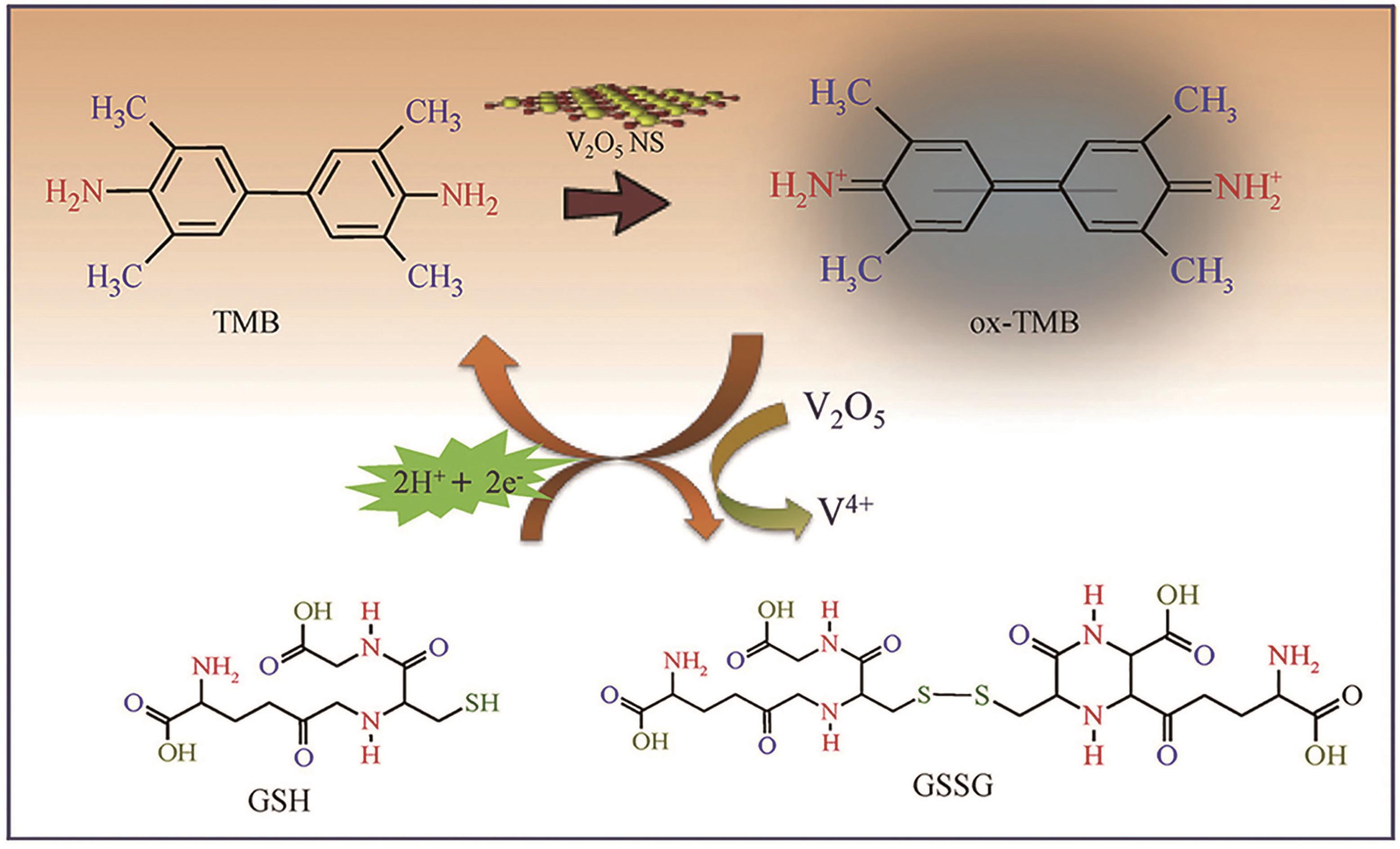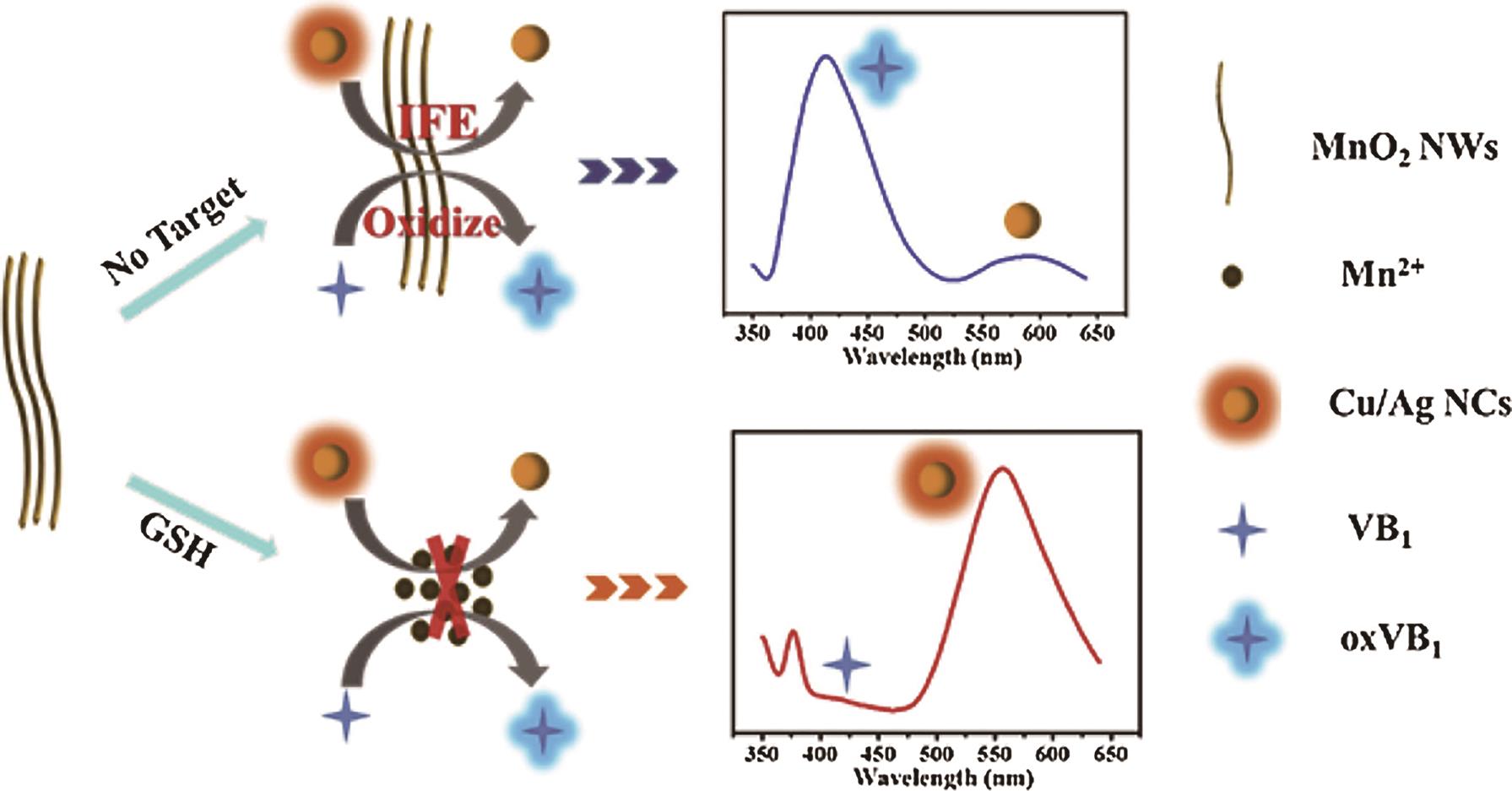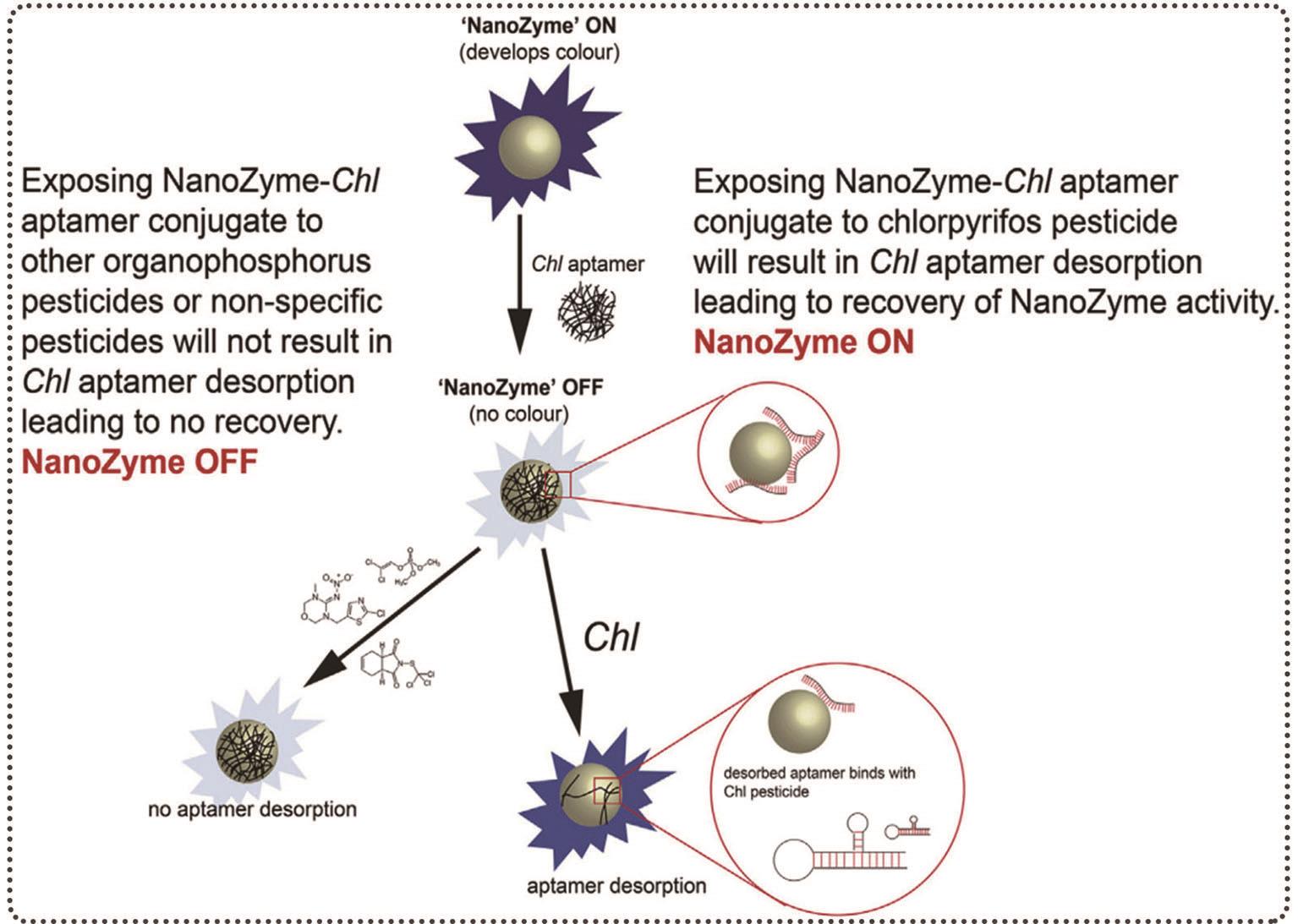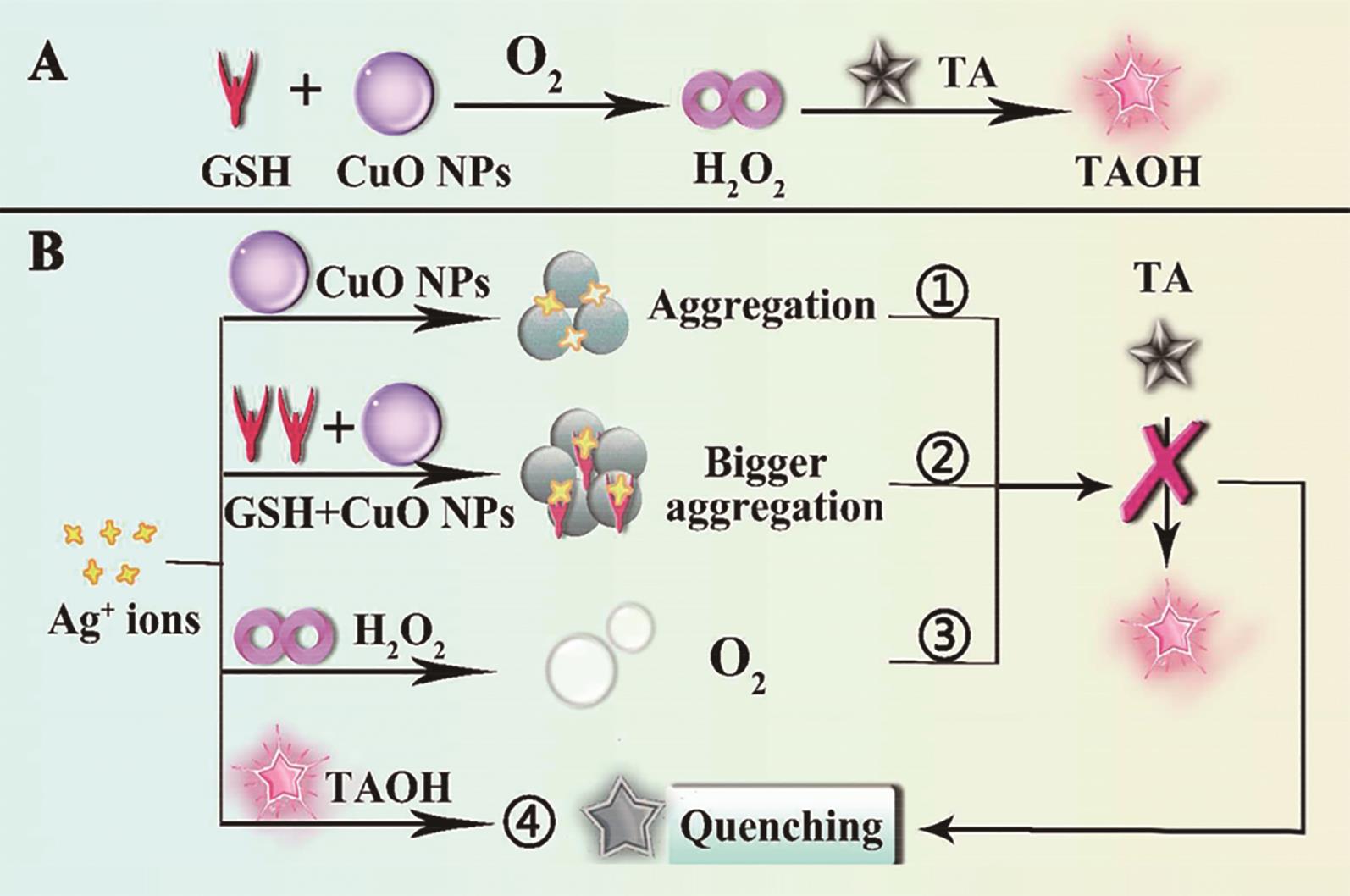
Chinese Journal of Applied Chemistry ›› 2024, Vol. 41 ›› Issue (1): 60-86.DOI: 10.19894/j.issn.1000-0518.230286
• Review • Previous Articles Next Articles
Research Progress on the Application of Inorganic Nanoparticle Enzyme in the Field of Analytical Sensing
Jian-Tian LU, Jin-Hui ZOU, Bo-Lin ZHAO( ), Yu-Wei ZHANG(
), Yu-Wei ZHANG( )
)
- School of Chemistry and Chemical Engineering,Guangzhou University,Guangzhou 510006,China
-
Received:2023-09-21Accepted:2023-12-15Published:2024-01-01Online:2024-01-30 -
Contact:Bo-Lin ZHAO,Yu-Wei ZHANG -
About author:zhaobolin@gzhu.edu.cn
ccywzhang@gzhu.edu.cn;
-
Supported by:the National Natural Science Foundation of China (No.?22122402) and the Natural Science Foundation of Guangdong Province(2021B1515020048)
CLC Number:
Cite this article
Jian-Tian LU, Jin-Hui ZOU, Bo-Lin ZHAO, Yu-Wei ZHANG. Research Progress on the Application of Inorganic Nanoparticle Enzyme in the Field of Analytical Sensing[J]. Chinese Journal of Applied Chemistry, 2024, 41(1): 60-86.
share this article
Add to citation manager EndNote|Ris|BibTeX
URL: http://yyhx.ciac.jl.cn/EN/10.19894/j.issn.1000-0518.230286
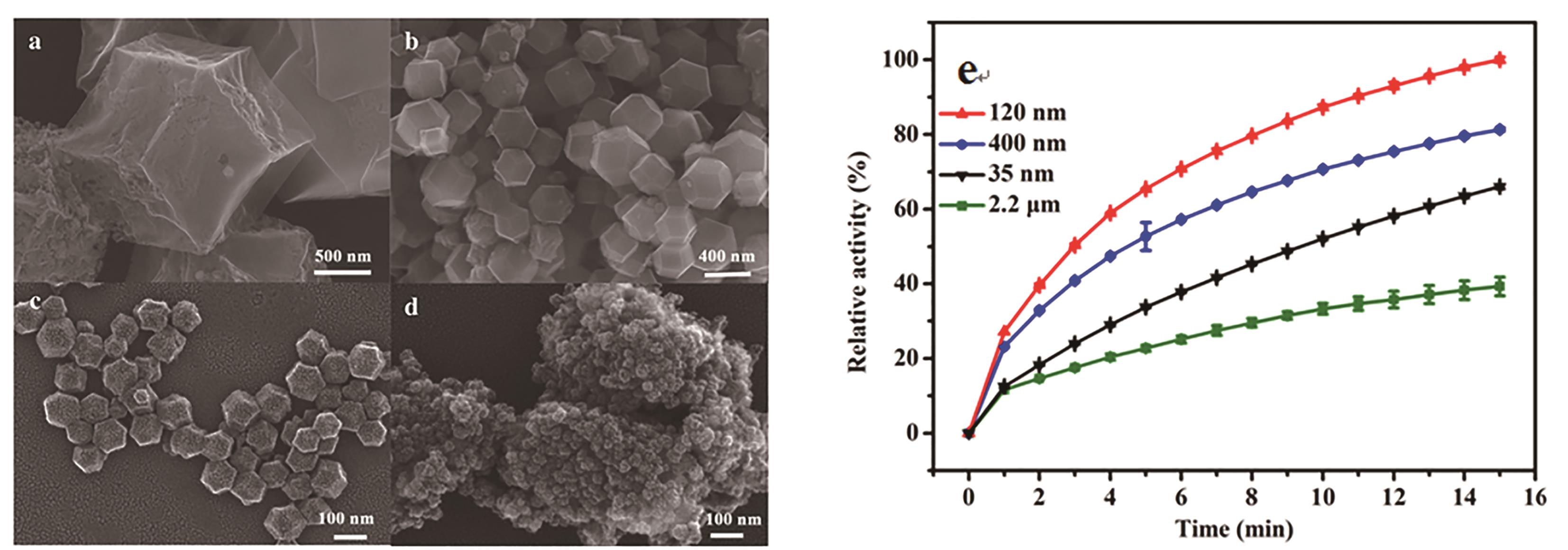
图1 Fe-N/C催化剂(a) 2200、 (b) 400、 (c) 120和(d) 35 nm下的SEM图; (e) Fe-N/C催化剂的尺寸与氧化活性的关系图[17]Fig.?1 SEM images of Fe-N/C catalysts with size of 2200 (a), 400 (b), 120 (c) and 35 nm (d), respectively; (e) The size-dependent oxidase-like activities of Fe-N/C catalysts with different sizes[17]
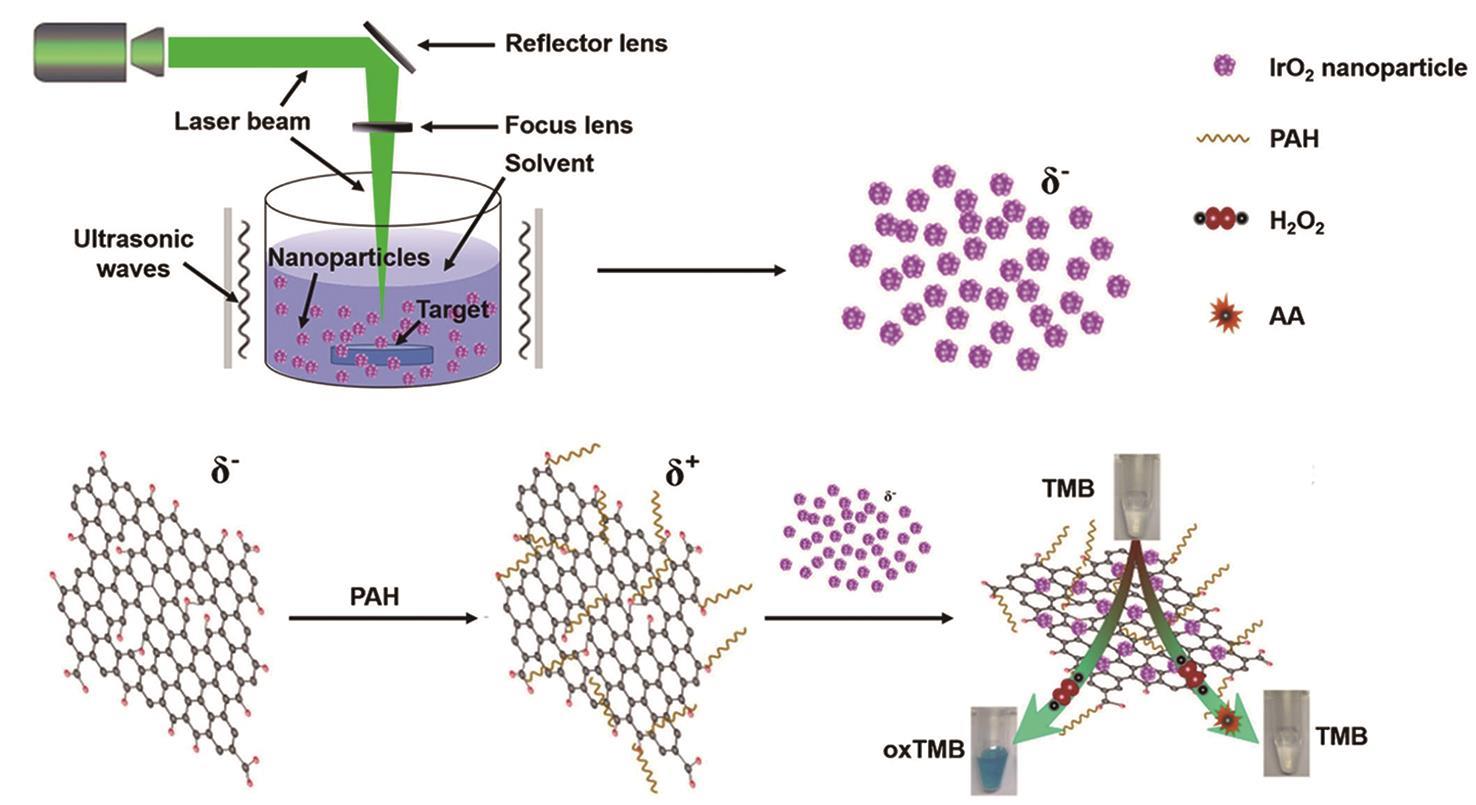
Fig.4 Schematic illustration of the preparation of PAH stabilized IrO2/GO nanocomposites and the colorimetric detection of AA based on the peroxidase-like activity of IrO2/GO nanocomposites[30]
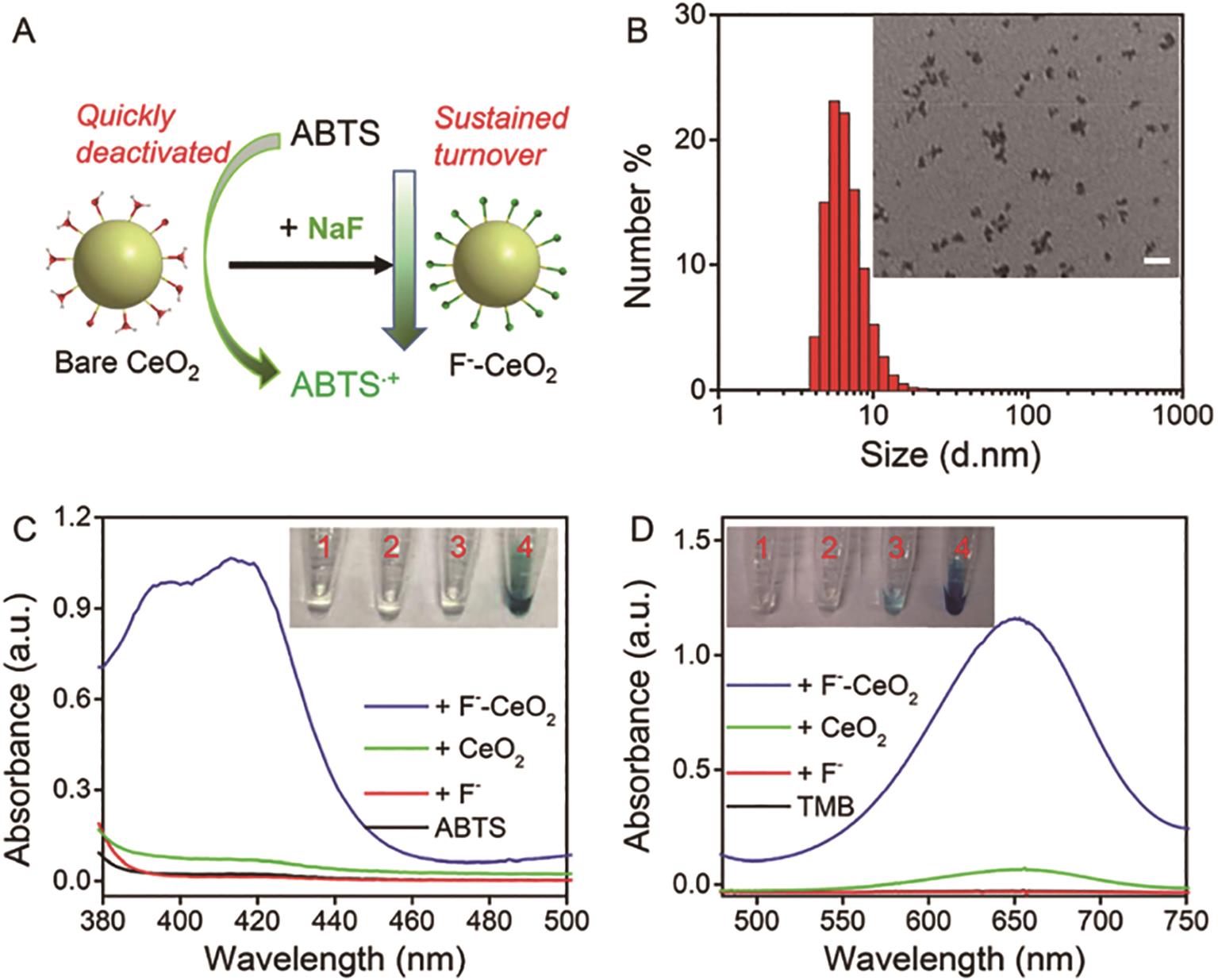
Fig.5 (A) A scheme showing F--capped nanoceria with improved oxidase turnovers; (B) DLS size distribution and a TEM image (inset) of nanoceria; UV-Vis spectra of (C) ABTS (0.5 mmol/L) and (D) TMB (1 mmol/L) oxidation by nanoceria[38]
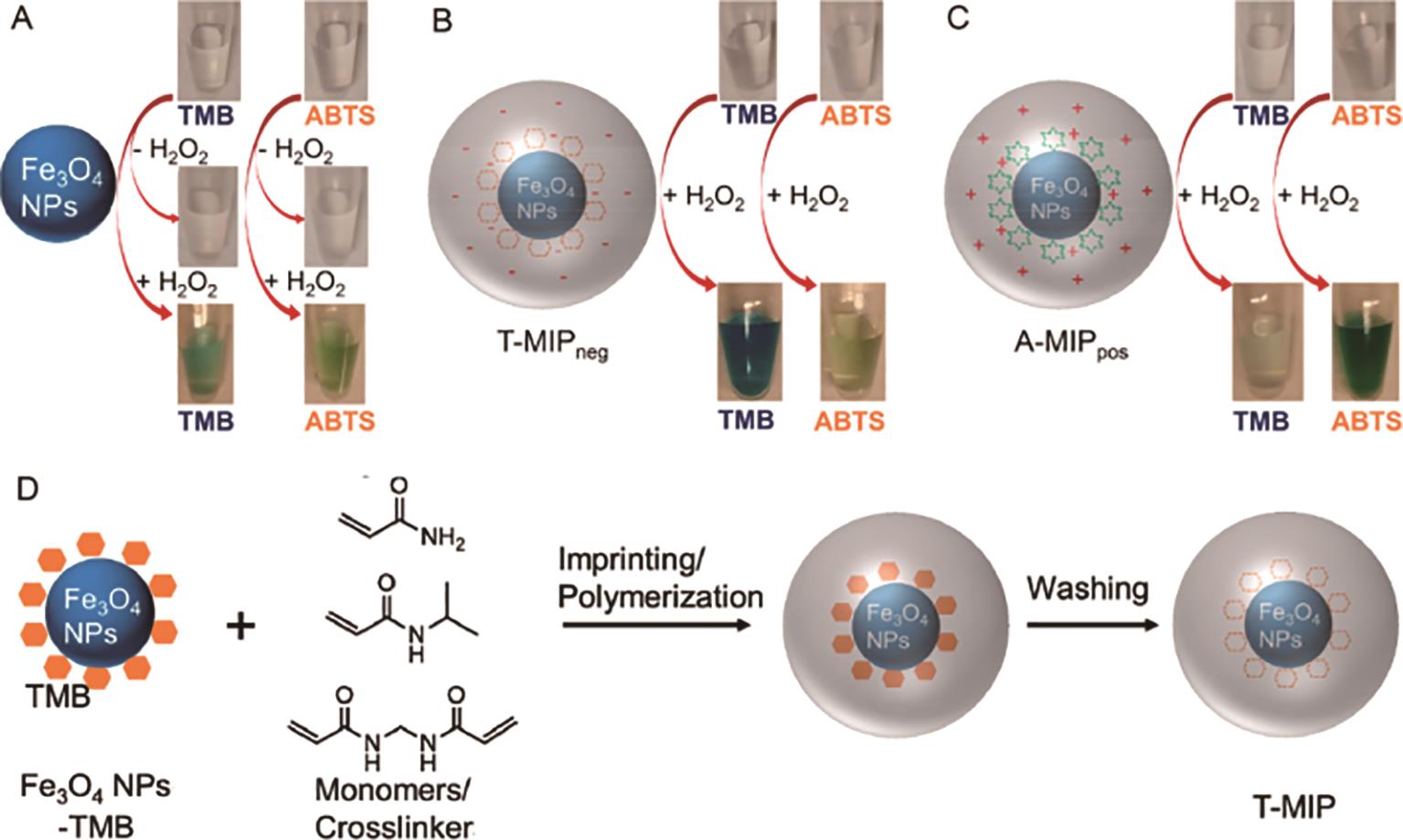
Fig.6 Photographs showing the activity and specificity of (A) Fe3O4 NPs, (B) T-MIPneg and (C) A-MIPpos nanogels for oxidation of TMB and ABTS with or without H2O2; (D) A scheme of imprinting TMB on Fe3O4 NPs[40]
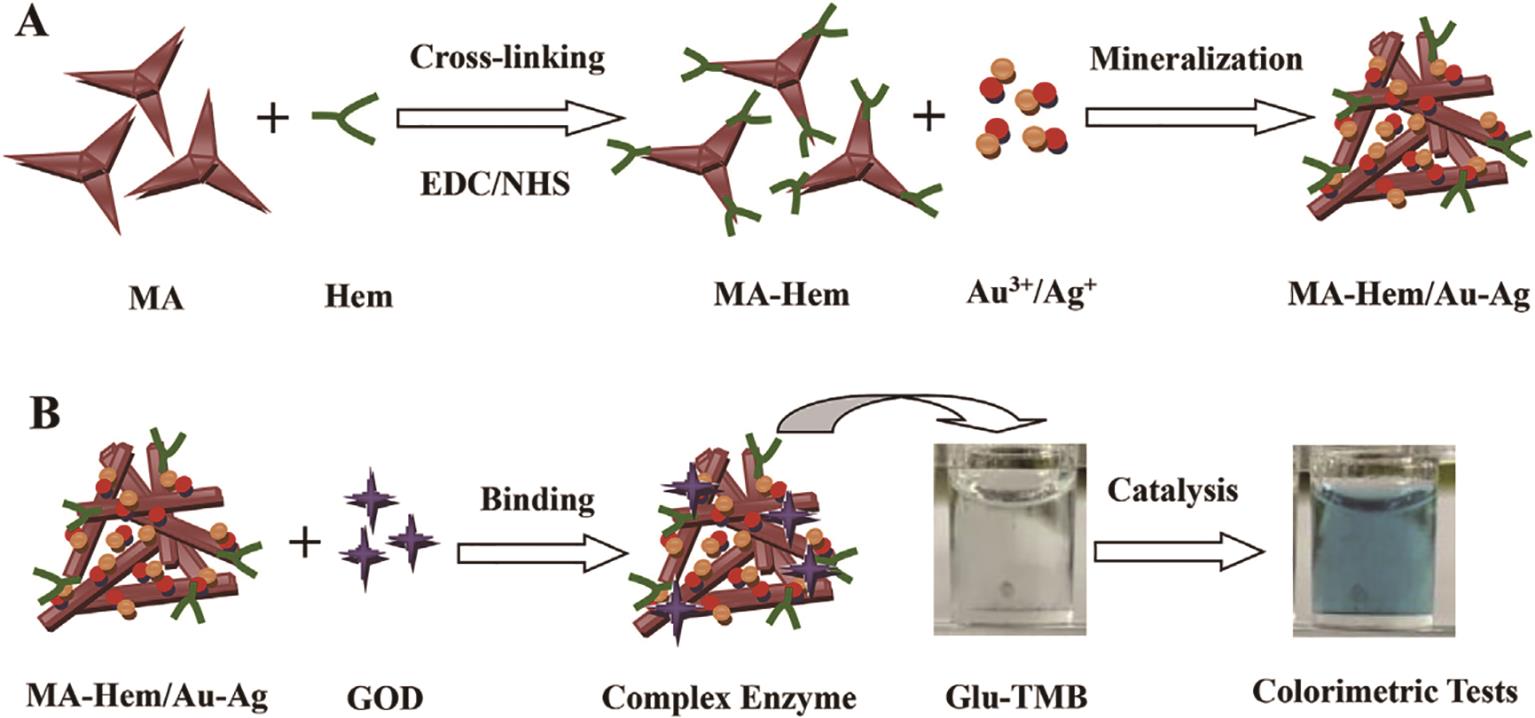
Fig.11 Schematic illustration of (A) the fabrication procedure of MA-Hem/AueAg nanocomposite nanozymes and (B) the catalysis-based colorimetric test for glucose[58]
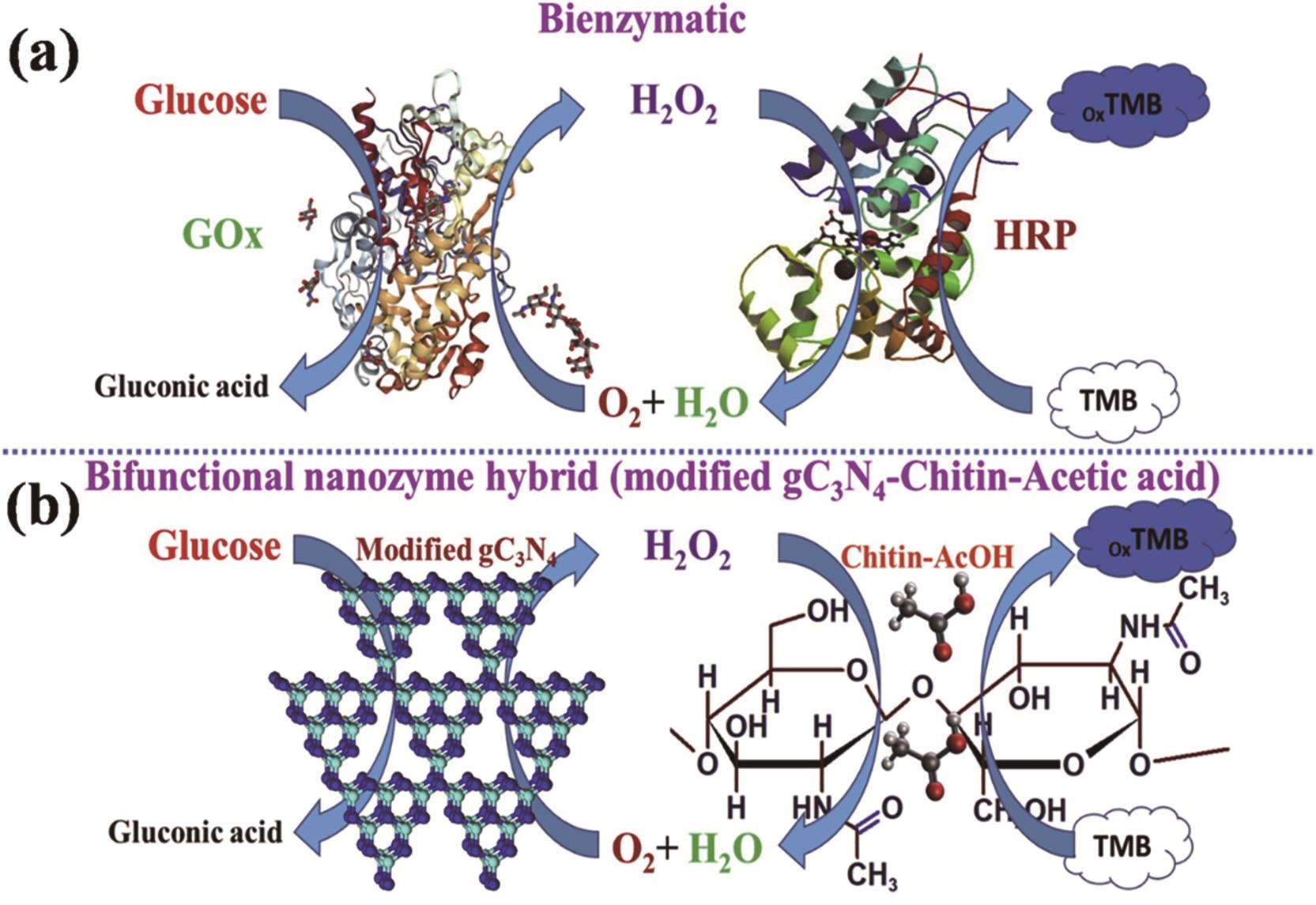
Fig.12 (a) Enzymatic scheme of GOx and HRP with H2O2-mediated TMB oxidation; (b) Non-enzymatic glucose recognition using a biomimetic nanozyme cascade method of MGCN for glucose oxidation with subsequent in-situ generation of H2O2 and chitin-AcOH for decomposition of H2O2 and TMB oxidation[60]

Fig.15 Schematic illustration of the preparation of laccase mimicking CH-Cu nanozymes, which resembles the catalytic center of natural laccase. PDB code of the laccase is 1V10[65]
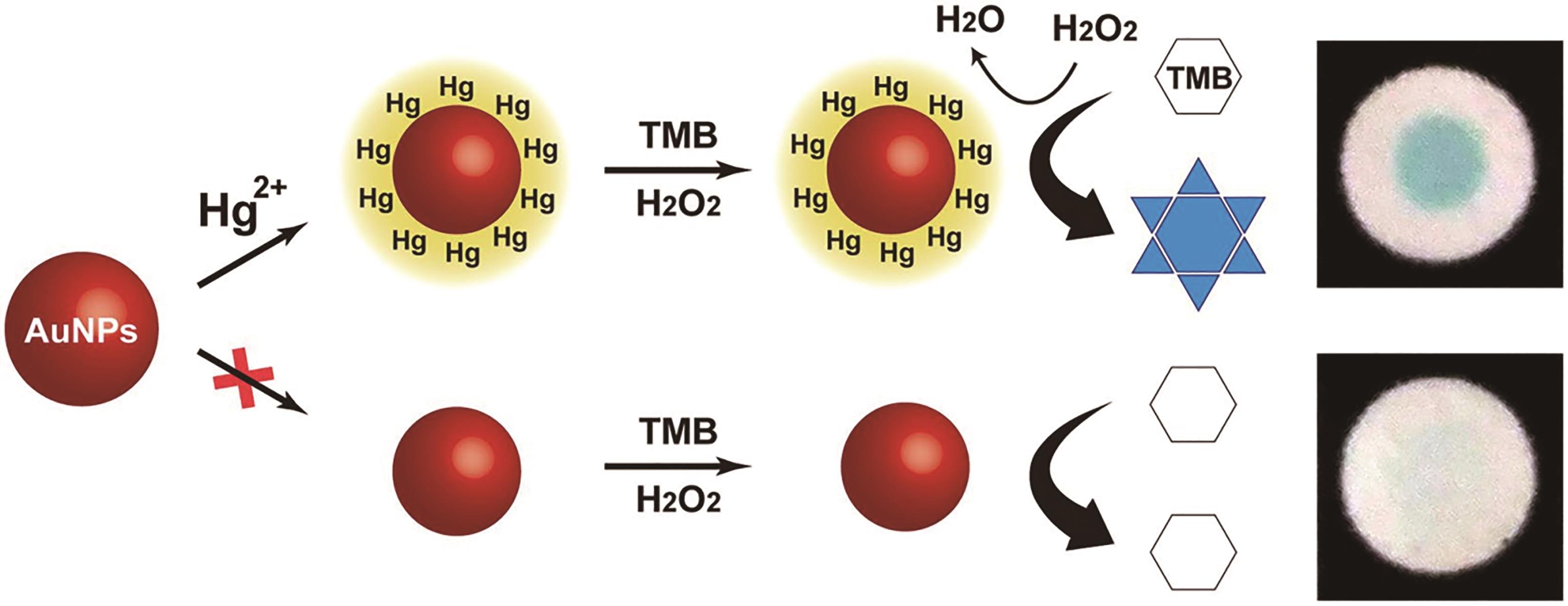
Fig.18 Schematic illustration of the AuNZ-PAD colorimetric sensing mechanism for Hg2+ ions based on the mercury-promoted nanozyme activity of AuNPs[72]

Fig.20 Representation of the decomposition of H2O2 catalyzed by CuS nanoparticles in the presence of Cr2O72- ions in acidic medium to generate ·OH- radicals and formation of fluorescent active TA-OH complex upon reaction with terephthalic acid[77]

Fig.22 Schematic representation of (A) the preparation of CoOxH-GO nanohybrid for the catalysis of H2O2 mediated oxidation of AR to resorufin, (B) glucose oxidase coupled with peroxidase-like CoOxH-GO nanohybrid for the detection of glucose, (C) detection of CN- ions based on the inhibition of the enzymatic activity of CoOxH-GO nanohybrid and (D) the fabrication of CoOxH-GO/N+M for sensing of cyanide ions[87]
| 1 | SHENG J, WU Y, DING H, et al. Multienzyme-like nanozymes: regulation, rational design, and application[J]. Adv Mater, 2023: 2211210. |
| 2 | DONG K, XU C, REN J S, et al. Chiral nanozymes for enantioselective biological catalysis[J]. Angew Chem Int Edit, 2022, 61(43): e202208757. |
| 3 | WU W, HUANG L, ZHU X, et al. Reversible inhibition of the oxidase-like activity of Fe single-atom nanozymes for drug detection[J]. Chem Sci, 2022, 13(16): 4566-4572. |
| 4 | BRESLOW R, OVERMAN L E. Artificial enzyme combining a metal catalytic group and a hydrophobic binding cavity[J]. J Am Chem Soc, 1970, 92(4): 1075-1077. |
| 5 | MIKOLAJCZAK D J, BERGER A A, KOKSCH B. Catalytically active peptide-gold nanoparticle conjugates: prospecting for artificial enzymes[J]. Angew Chem Int Ed, 2020, 59(23): 8776-8785. |
| 6 | MANEA F, HOUILLON F B, PASQUATO L, et al. Nanozymes: gold-nanoparticle-based transphosphorylation catalysts[J]. Angew Chem Int Edit, 2004, 43(45): 6165-6169. |
| 7 | JIAO L, YAN H Y, WU Y, et al. When nanozymes meet single-atom catalysis[J]. Angew Chem Int Edit, 2020, 59(7): 2565-2576. |
| 8 | ZHANG L, WANG H, QU X. Biosystem‐inspired engineering of nanozymes for biomedical applications[J]. Adv Mater, 2023: 2211147. |
| 9 | HOU J, XIANYU Y. Tailoring the surface and composition of nanozymes for enhanced bacterial binding and antibacterial activity[J]. Small, 2023, 19(42): 2302640. |
| 10 | HUANG Y Y, REN J S, QU X G. Nanozymes: classification, catalytic mechanisms, activity regulation, and applications[J]. Chem Rev, 2019, 119(6): 4357-4412. |
| 11 | XU D, WU L, YAO H, et al. Catalase-like nanozymes: classification, catalytic mechanisms, and their applications[J]. Small, 2022, 18(37): 2203400. |
| 12 | ASATI A, SANTRA S, KAITTANIS C, et al. Oxidase-like activity of polymer-coated cerium oxide nanoparticles[J]. Angew Chem Int Ed, 2009, 48(13): 2308-2312. |
| 13 | COMOTTI M, DELLA PINA C, MATARRESE R, et al. The catalytic activity of “naked” gold particles[J]. Angew Chem Int Ed, 2004, 43(43): 5812-5815. |
| 14 | LI B, LONG R, ZHONG X L, et al. Investigation of size-dependent plasmonic and catalytic properties of metallic nanocrystals enabled by size control with HCl oxidative etching[J]. Small, 2012, 8(11): 1710-1716. |
| 15 | PENG F F, ZHANG Y, GU N. Size-dependent peroxidase-like catalytic activity of Fe3O4 nanoparticles[J]. Chin Chem Lett, 2008, 19(6): 730-733. |
| 16 | XIA F, HU X, ZHANG B, et al. Ultrasmall ruthenium nanoparticles with boosted antioxidant activity upregulate regulatory T cells for highly efficient liver injury therapy[J]. Small, 2022, 18(29): 2201558. |
| 17 | CHEN Q, LI S, LIU Y, et al. Size-controllable Fe-N/C single-atom nanozyme with exceptional oxidase-like activity for sensitive detection of alkaline phosphatase[J]. Sens Actuators B: Chem, 2020, 305: 127511. |
| 18 | XI Z, GAO W W, XIA X H. Size effect in Pd-Ir core-shell nanoparticles as nanozymes[J]. ChemBioChem, 2020, 21(17): 2440-2444. |
| 19 | WEI X S, LI X F, FENG Y Q, et al. Morphology- and pH-dependent peroxidase mimetic activity of nanoceria[J]. RSC Adv, 2018, 8(21): 11764-11770. |
| 20 | TIAN R, SUN J H, QI Y F, et al. Influence of VO2 nanoparticle morphology on the colorimetric assay of H2O2 and glucose[J]. Nanomaterials-Basel, 2017, 7(11): 347. |
| 21 | GE C C, FANG G, SHEN X M, et al. Facet energy versus enzyme-like activities: the unexpected protection of palladium nanocrystals against oxidative damage[J]. ACS Nano, 2016, 10(11): 10436-10445. |
| 22 | XIE W, ZHANG G, GUO Z, et al. Shape-controllable and kinetically miscible copper-palladium bimetallic nanozymes with enhanced fenton-like performance for biocatalysis[J]. Mater Today Bio, 2022, 16: 100411. |
| 23 | XU Z, JIANG J, LI Y, et al. Shape-regulated photothermal-catalytic tumor therapy using polydopamine@Pt nanozymes with the elicitation of an immune response[J]. Small, 2023: 2309096. |
| 24 | HUANG L, ZHANG W, CHEN K, et al. Facet-selective response of trigger molecule to CeO2 {1 1 0} for up-regulating oxidase-like activity[J]. Chem Eng J, 2017, 330: 746-752. |
| 25 | VERNEKAR A A, DAS T, GHOSH S, et al. A remarkably efficient MnFe2O4-based oxidase nanozyme[J]. Chem Asian J, 2016, 11(1): 72-76. |
| 26 | SINGH S, TRIPATHI P, KUMAR N, et al. Colorimetric sensing of malathion using palladium-gold bimetallic nanozyme[J]. Biosens Bioelectron, 2017, 92: 280-286. |
| 27 | WU J J X, QIN K, YUAN D, et al. Rational design of Au@Pt multibranched nanostructures as bifunctional nanozymes[J]. ACS Appl Mater Inter, 2018, 10(15): 12954-12959. |
| 28 | LV F, GONG Y Z, CAO Y Y, et al. A convenient detection system consisting of efficient Au@PtRu nanozymes and alcohol oxidase for highly sensitive alcohol biosensing[J]. Nanoscale Adv, 2020, 2(4): 1583-1589. |
| 29 | JIN Z Y, XU G F, NIU Y S, et al. Ti3C2Tx mxene-derived TiO2/C-QDs as oxidase mimics for the efficient diagnosis of glutathione in human serum[J]. J Mater Chem B, 2020, 8(16): 3513-3518. |
| 30 | SUN H Y, LIU X L, WANG X H, et al. Colorimetric determination of ascorbic acid using a polyallylamine-stabilized IrO2/graphene oxide nanozyme as a peroxidase mimic[J]. Microchim Acta, 2020, 187(2): 110. |
| 31 | WAN X, GE Y, ZHANG J, et al. A covalent organic framework derived N-doped carbon nanozyme as the all-rounder for targeted catalytic therapy and NIR-Ⅱ photothermal therapy of cancer[J]. ACS Appl Mater Inter, 2023, 15(38): 44763-44772. |
| 32 | WANG R, ZHANG T, ZHANG W, et al. Microperoxidase-11 functionalized nanozyme with enhanced peroxidase-mimicking activities for visual detection of cysteine[J]. Anal Chim Acta, 2023, 1267: 341386. |
| 33 | FENG N, LI Q, BAI Q, et al. Development of an Au-anchored Fe single-atom nanozyme for biocatalysis and enhanced tumor photothermal therapy[J]. J Colloid Interface Sci, 2022, 618: 68-77. |
| 34 | HE N, ZHU X, LIU F, et al. Rational design of FeS2-encapsulated covalent organic frameworks as stable and reusable nanozyme for dual-signal detection glutathione in cell lysates[J]. Chem Eng J, 2022, 445: 136543. |
| 35 | LIU B W, LIU J W. Surface modification of nanozymes[J]. Nano Res, 2017, 10(4): 1125-1148. |
| 36 | NAHA P C, LIU Y, HWANG G, et al. Dextran-coated iron oxide nanoparticles as biomimetic catalysts for localized and pH-activated biofilm disruption[J]. ACS Nano, 2019, 13(5): 4960-4971. |
| 37 | LU W H, ZHANG J X, LI N L, et al. Co3O4@beta-cyclodextrin with synergistic peroxidase-mimicking performance as a signal magnification approach for colorimetric determination of ascorbic acid[J]. Sens Actuators B: Chem, 2020, 303: 127106. |
| 38 | LIU B W, HUANG Z C, LIU J W. Boosting the oxidase mimicking activity of nanoceria by fluoride capping: rivaling protein enzymes and ultrasensitive F- detection[J]. Nanoscale, 2016, 8(28): 13562-13567. |
| 39 | SONG J Y, LI H F, SHEN H, et al. Fluoride capped V6O13-reduced graphene oxide nanocomposites: high activity oxidase mimetics and mechanism investigation[J]. New J Chem, 2019, 43(48): 19053-19062. |
| 40 | ZHANG Z J, ZHANG X H, LIU B W, et al. Molecular imprinting on inorganic nanozymes for hundred-fold enzyme specificity[J]. J Am Chem Soc, 2017, 139(15): 5412-5419. |
| 41 | FENG M, LI X, ZHANG X, et al. Recent advances in the development and analytical applications of oxidase-like nanozymes[J]. TrAC-Trends Anal Chem, 2023, 166: 117220. |
| 42 | CHI Z, WANG Q, GU J. Recent advances in colorimetric sensors based on nanozymes with peroxidase-like activity[J]. The Analyst, 2023, 148(3): 487-506. |
| 43 | GONG X J, LIU Y, YANG Z H, et al. An “on-off-on” fluorescent nanoprobe for recognition of chromium(Ⅵ) and ascorbic acid based on phosphorus/nitrogen dualdoped carbon quantum dot[J]. Anal Chim Acta, 2017, 968: 85-96. |
| 44 | WANG K, LIU J, WANG X, et al. Ratiometric fluorescent detection system based on dual-driving catalysis of CuO nanozyme with a classical univariate calibration for the determination of ascorbic acid in serum and fruits[J]. Microchem J, 2022, 172: 106921. |
| 45 | LIU B, XUE Y T, GAO Z Y, et al. Antioxidant identification using a colorimetric sensor array based on Co-N-C nanozyme[J]. Colloid Surface B, 2021, 208: 112060. |
| 46 | ZHANG J, LV Y L, ZHANG W, et al. A flavone-based turn-on fluorescent probe for intracellular cysteine/homocysteine sensing with high selectivity[J]. Talanta, 2016, 146: 41-48. |
| 47 | CHEN C, WANG Y, ZHANG D. Peroxidase-like activity of vanadium tetrasulfide submicrospheres and its application to the colorimetric detection of hydrogen peroxide and L-cysteine[J]. Microchim Acta, 2019, 186(12): 784. |
| 48 | LI Y F, ZHANG Z Y, TAO Z H, et al. A Asp/Ce nanotube-based colorimetric nanosensor for H2O2-free and enzyme-free detection of cysteine[J]. Talanta, 2019, 196: 556-562. |
| 49 | SUN L J, LIU C, SUN J W. Penguin with bow tie-like bimetallic metal organic framework as colorimetric biosensing for H2O2 and L-cysteine[J]. J Coord Chem, 2021, 74(11): 1891-1906. |
| 50 | JIN T, LI Y L, JING W J, et al. Cobalt-based metal organic frameworks: a highly active oxidase-mimicking nanozyme for fluorescence “turn-on” assays of biothiol[J]. Chem Commun, 2020, 56(4): 659-662. |
| 51 | LI X, ZHOU H, QI F, et al. Three hidden talents in one framework: a terephthalic acid-coordinated cupric metal-organic framework with cascade cysteine oxidase- and peroxidase-mimicking activities and stimulus-responsive fluorescence for cysteine sensing[J]. J Mater Chem B, 2019, 7(15): 2565-2565. |
| 52 | QI S J, LIU W M, ZHANG P P, et al. A colorimetric and ratiometric fluorescent probe for highly selective detection of glutathione in the mitochondria of living cells[J]. Sens Actuators B: Chem, 2018, 270: 459-465. |
| 53 | LI W Y, WANG J Y, ZHU J C, et al. Co3O4 nanocrystals as an efficient catalase mimic for the colorimetric detection of glutathione[J]. J Mater Chem B, 2018, 6(42): 6858-6864. |
| 54 | GANGANBOINA A B, DOONG R A. The biomimic oxidase activity of layered V2O5 nanozyme for rapid and sensitive nanomolar detection of glutathione[J]. Sens Actuators B: Chem, 2018, 273: 1179-1186. |
| 55 | TAN X F, ZHANG L H, TANG Q R, et al. Ratiometric fluorescent immunoassay for the cardiac troponin-i using carbon dots and palladium-iridium nanocubes with peroxidase-mimicking activity[J]. Microchim Acta, 2019, 186(5): 280. |
| 56 | HU X, LIU X D, ZHANG X D, et al. MnO2 nanowires tuning of photoluminescence of alloy Cu/Ag NCs and thiamine enables a ratiometric fluorescent sensing of glutathione[J]. Sens Actuators B: Chem, 2019, 286: 476-482. |
| 57 | LIU A, LI M M, WANG J X, et al. Ag@Au core/shell triangular nanoplates with dual enzyme-like properties for the colorimetric sensing of glucose[J]. Chin Chem Lett, 2020, 31(5): 1133-1136. |
| 58 | LIU H, HUA Y, CAI Y Y, et al. Mineralizing gold-silver bimetals into hemin-melamine matrix: a nanocomposite nanozyme for visual colorimetric analysis of H2O2 and glucose[J]. Anal Chim Acta, 2019, 1092: 57-65. |
| 59 | ADENIYI O, SICWETSHA S, MASHAZI P. Nanomagnet-silica nanoparticles decorated with Au@Pd for enhanced peroxidase-like activity and colorimetric glucose sensing [J]. ACS Appl Mater Inter, 2019, 12(2): 1973-1987. |
| 60 | SENGUPTA P, PRAMANIK K, DATTA P, et al. Chemically modified carbon nitride-chitin-acetic acid hybrid as a metal-free bifunctional nanozyme cascade of glucose oxidase-peroxidase for “click off” colorimetric detection of peroxide and glucose[J]. Biosens Bioelectron, 2020, 154: 112072. |
| 61 | LIU S G, HAN L, LI N, et al. A fluorescence and colorimetric dual-mode assay of alkaline phosphatase activity via destroying oxidase-like coooh nanoflakes[J]. J Mater Chem B, 2018, 6(18): 2843-2850. |
| 62 | ZHANG C, NI P, WANG B, et al. Enhanced oxidase-like activity of g-C3N4 nanosheets supported Pd nanosheets for ratiometric fluorescence detection of acetylcholinesterase activity and its inhibitor[J]. Chin Chem Lett, 2022, 33(2): 757-761. |
| 63 | JIANG J F, HE C Y, WANG S, et al. Recyclable ferromagnetic chitosan nanozyme for decomposing phenol[J]. Carbohyd Polym, 2018, 198: 348-353. |
| 64 | WANG B, HUANG B, JIN W, et al. Occurrence, distribution, and sources of six phenolic endocrine disrupting chemicals in the 22 river estuaries around dianchi lake in china[J]. Environ Sci Pollut R, 2013, 20(5): 3185-3194. |
| 65 | WANG J H, HUANG R L, QI W, et al. Construction of a bioinspired laccase-mimicking nanozyme for the degradation and detection of phenolic pollutants [J]. Appl Catal B: Environ, 2019, 254: 452-462. |
| 66 | XU X J, WANG J H, HUANG R L, et al. Preparation of laccase mimicking nanozymes and their catalytic oxidation of phenolic pollutants[J]. Catal Sci Technol, 2021, 11(10): 3402-3410. |
| 67 | KOYAPPAYIL A, KIM H T, LEE M H. “Laccase-like” properties of coral-like silver citrate micro-structures for the degradation and determination of phenolic pollutants and adrenaline[J]. J Hazard Mater, 2021, 412: 125211. |
| 68 | LIANG X, HAN L. White peroxidase-mimicking nanozymes: colorimetric pesticide assay without interferences of O2 and color[J]. Adv Funct Mater, 2020, 30(28): 2001933. |
| 69 | WEERATHUNGE P, BEHERA B K, ZIHARA S, et al. Dynamic interactions between peroxidase-mimic silver nanozymes and chlorpyrifos-specific aptamers enable highly-specific pesticide sensing in river water[J]. Anal Chim Acta, 2019, 1083: 157-165. |
| 70 | HUANG L J, SUN D W, PU H B, et al. A colorimetric paper sensor based on the domino reaction of acetylcholinesterase and degradable gamma-mnooh nanozyme for sensitive detection of organophosphorus pesticides[J]. Sens Actuators B: Chem, 2019, 290: 573-580. |
| 71 | LI Q, WU F, MAO M, et al. A dual-mode colorimetric sensor based on copper nanoparticles for the detection of mercury-(Ⅱ) ions[J]. Anal Methods, 2019, 11(31): 4014-4021. |
| 72 | HAN K N, CHOI J S, KWON J. Gold nanozyme-based paper chip for colorimetric detection of mercury ions[J]. Sci Rep, 2017, 7: 2086. |
| 73 | NIU X H, HE Y F, LI X, et al. A peroxidase-mimicking nanosensor with Hg2+-triggered enzymatic activity of cysteine-decorated ferromagnetic particles for ultrasensitive Hg2+ detection in environmental and biological fluids[J]. Sens Actuators B: Chem, 2019, 281: 445-452. |
| 74 | FANG Y M, ZHANG Y, CAO L G, et al. Portable Hg2+ nanosensor with ppt level sensitivity using nanozyme as the recognition unit, enrichment carrier, and signal amplifier[J]. ACS Appl Mater Inter, 2020, 12(10): 11761-11768. |
| 75 | ZHUANG Y T, CHEN S, JIANG R, et al. Ultrasensitive colorimetric chromium chemosensor based on dye color switching under the Cr(Ⅵ)-stimulated Au NPs catalytic activity[J]. Anal Chem, 2019, 91(8): 5346-5353. |
| 76 | XUE Q S, LI X, PENG Y X, et al. Polyethylenimine-stabilized silver nanoclusters act as an oxidoreductase mimic for colorimetric determination of chromium(Ⅵ)[J]. Microchim Acta, 2020, 187(5): 263. |
| 77 | BORTHAKUR P, DAS M R, SZUNERITS S, et al. CuS decorated functionalized reduced graphene oxide: a dual responsive nanozyme for selective detection and photoreduction of Cr(Ⅵ) in an aqueous medium[J]. ACS Sustainable Chem Eng, 2019, 7(19): 16131-16143. |
| 78 | FU H Y, YIN Q B, WANG H L, et al. Target-triggered in situ autocatalysis in nanopore membrane for point-of-care testing of sub-nanomolar Ag+[J]. Sens Actuators B: Chem, 2019, 287: 290-295. |
| 79 | THAMARAISELVI P, DURAIPANDY N, KIRAN M S, et al. Triarylamine rhodanine derivatives as red emissive sensor for discriminative detection of Ag+ and Hg2+ ions in buffer-free aqueous solutions[J]. ACS Sustainable Chem Eng, 2019, 7(11): 9865-9874. |
| 80 | ZHAO C, KONG X G, SHUANG S M, et al. An anthraquinone-imidazole-based colorimetric and fluorescent sensor for the sequential detection of Ag+ and biothiols in living cells[J]. Analyst, 2020, 145(8): 3029-3037. |
| 81 | HE L Y, LU Y X, GAO X Y, et al. Self-cascade system based on cupric oxide nanoparticles as dual-functional enzyme mimics for ultrasensitive detection of silver ions[J]. ACS Sustainable Chem Eng, 2018, 6(9): 12132-12139. |
| 82 | JIMENEZ D, MARTINEZ-MANEZ R, SANCENON F, et al. A new chromo-chemodosimeter selective for sulfide anion[J]. J Am Chem Soc, 2003, 125(30): 9000-9001. |
| 83 | SONG S S, SONG D D, TANG H C, et al. Ionogels as precursors to prepare zns nanoparticles for colorimetric sensing of sulfide ions[J]. ACS Sustainable Chem Eng, 2020, 8(2): 759-770. |
| 84 | LIU X N, HUANG L J, WANG Y P, et al. One-pot bottom-up fabrication of a 2D/2D heterojuncted nanozyme towards optimized peroxidase-like activity for sulfide ions sensing[J]. Sens Actuators B: Chem, 2020, 306: 127565. |
| 85 | BAI C B, LIU X Y, ZHANG J, et al. Using smartphone app to determine the CN- concentration quantitatively in tap water: synthesis of the naked-eye colorimetric chemosensor for CN- and Ni2+ based on benzothiazole[J]. ACS Omega, 2020, 5(5): 2488-2494. |
| 86 | DAI Z, BOON E M. Engineering of the heme pocket of an H-Nox domain for direct cyanide detection and quantification[J]. J Am Chem Soc, 2010, 132(33): 11496-11503. |
| 87 | LIEN C W, UNNIKRISHNAN B, HARROUN S G, et al. Visual detection of cyanide ions by membrane-based nanozyme assay[J]. Biosens Bioelectron, 2018, 102: 510-517. |
| 88 | NATH P, PRIYADARSHNI N, CHANDA N. Europium-coordinated gold nanoparticles on paper for the colorimetric detection of arsenic(Ⅲ, Ⅴ) in aqueous solution[J]. ACS Appl Nano Mater, 2018, 1(1): 73-81. |
| 89 | PRIYADARSHNI N, NATH P, NAGAHANUMAIAH, et al. Dmsa-functionalized gold nanorod on paper for colorimetric detection and estimation of arsenic (Ⅲ and Ⅴ) contamination in groundwater[J]. ACS Sustainable Chem Eng, 2018, 6(5): 6264-6272. |
| 90 | WEN S H, ZHONG X L, WU Y D, et al. Colorimetric assay conversion to highly sensitive electrochemical assay for bimodal detection of arsenate based on cobalt oxyhydroxide nanozyme via arsenate absorption[J]. Anal Chem, 2019, 91(10): 6487-6497. |
| [1] | Yang SHU, Man YANG, Zhi-Hao LI, Jian-Hua WANG. MicroRNA Sensing Based on Gold Nanoparticle Aggregation and Hybridization Chain Amplification [J]. Chinese Journal of Applied Chemistry, 2024, 41(1): 109-117. |
| [2] | Cui-Cui YANG, Xiao-Xue YE. Small Molecule Recognition Based Photoelectrochemical Sensor for Histidine Detection [J]. Chinese Journal of Applied Chemistry, 2024, 41(1): 128-136. |
| [3] | Xue-Min ZHOU, Shu-Zhen LYU, Guo-Fang ZHANG, Zhu-Mei CUI, Sai BI. A Near-Infrared-Driven Signal Amplification Fluorescence Biosensor Based on Upconversion Beacon Probe for microRNA Detection [J]. Chinese Journal of Applied Chemistry, 2024, 41(1): 137-146. |
| [4] | Yi XU, Meng-Yao LIN, Xiao-Qun GONG. Research Progress of Multicolor Colorimetric Method in Biosensing Platform [J]. Chinese Journal of Applied Chemistry, 2024, 41(1): 3-20. |
| [5] | Yu-Xuan LI, Yu-Hao ZHAO, Yu-Ze DAI, Min JIANG, Ying ZHANG, Guang-Yuan ZHOU. Preparation and Characterization of Poly(ethylene 2,5-furandicarboxylate)/TiO2 Nanoparticles/ Diatomaceous Earth Composites [J]. Chinese Journal of Applied Chemistry, 2023, 40(9): 1277-1287. |
| [6] | Yu-Wen YANG, Jing-Yao QI, Lin LI, Guo-Ning CHU, Sai WANG, Yu ZHANG, Shuang ZHANG. Selective Oxidation of 5-Hydroxymethylfurfural to 2,5-Furandicarboxylic Acid over Ru Supported on Magnetic NiFe2O4 [J]. Chinese Journal of Applied Chemistry, 2023, 40(6): 879-887. |
| [7] | Ding ZHANG, Wei-Wei YANG, Song-Song MIAO, Yi SU. Au Nanoparticles Confined in N-Doped Porous Carbon for Detection of Chlorine Dioxide in Liquid Phase [J]. Chinese Journal of Applied Chemistry, 2023, 40(11): 1572-1580. |
| [8] | Ye LIU, Shao-Bo GUO, Yan-Li LIANG, Hong-Guang GE, Jian-Qi MA, Zhi-Feng LIU, Bo LIU. Preparation and Catalytic Performance of Core‑Shell CuFe2O4@NH2@Pt Nanocomposites [J]. Chinese Journal of Applied Chemistry, 2022, 39(8): 1237-1245. |
| [9] | Wen-Dong WANG, Zai-Jun LI. Synthesis of Ruthenium‑Graphene Quantum Dots Artificial Oxidase and Its Application in Colorimetric Detection of Phoxim in Carrots [J]. Chinese Journal of Applied Chemistry, 2022, 39(8): 1285-1293. |
| [10] | Feng-Zhou XU, Hua-Ying TANG, Wu-Hui LIU, Yi-Feng JIANG, Wen-Kai LI, Xian-Hai LU. A Visual Semi⁃quantitative Method for Rapid Detection of Copper Ion in Water [J]. Chinese Journal of Applied Chemistry, 2022, 39(8): 1303-1311. |
| [11] | Hui DU, Chen-Yang YAO, Hao PENG, Bo JIANG, Shun-Xiang LI, Jun-Lie YAO, Fang ZHENG, Fang YANG, Ai-Guo WU. Applications of Transition Metal⁃doped Iron⁃based Nanoparticles in Biomedicine [J]. Chinese Journal of Applied Chemistry, 2022, 39(3): 391-406. |
| [12] | Tao GONG, Chao-Chao WEN, Kai-Li QIN, Ying-Zhu ZAHO, Yu-Qi ZHANG, Wen-Ting LIANG, Chuan DONG. Preparation of Formyl Deoxycholic Acid Modified Fe3O4 Nanoparticles and Their Application for Oxytetracycline Loading [J]. Chinese Journal of Applied Chemistry, 2022, 39(12): 1920-1926. |
| [13] | ZHAO Chang-Li, QIN Ming-Gao, DOU Xiao-Qiu, FENG Chuan-Liang. High Mechanical Stability and Osteogenesis of Chiral Supramolecular Hydrogel Induced by Inorganic Nanoparticles [J]. Chinese Journal of Applied Chemistry, 2022, 39(1): 177-187. |
| [14] | ZHANG Jin-Hong, SHI Kui, XU Peng, LI Qian, XUE Long-Jian. Regulation of Friction Force of a Water Droplet on Bioinspired Surface [J]. Chinese Journal of Applied Chemistry, 2022, 39(1): 188-195. |
| [15] | CUI Hao, WANG Qian-Qian, WANG Xiao-Lin, HE Xiang-Ming, XU Hong. Towards Extreme Ultraviolet Lithography: Progress and Challenges of Photoresists [J]. Chinese Journal of Applied Chemistry, 2021, 38(9): 1154-1167. |
| Viewed | ||||||
|
Full text |
|
|||||
|
Abstract |
|
|||||
